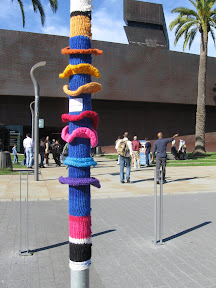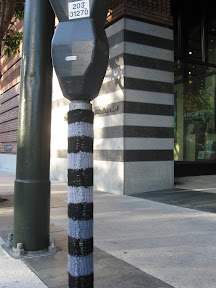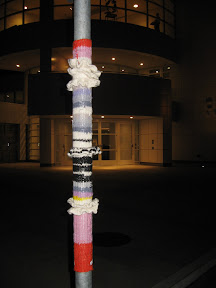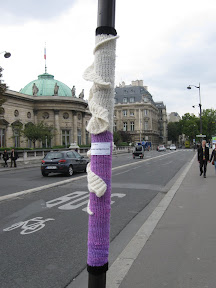Over the past two weeks, we’ve had Maria Mortati share with us the foundation of the San Francisco Mobile Museum and Barbara Stauffer discussing the challenges of orchestrating a participatory design experience in an institution. To round out the conversation, this final entry is from the street artist, and self proclaimed “yarn bomber”, Streetcolor.
 |
I am a Yarnbomber. Or I should say—I am a regular artist by day and a yarnbomber by night. Yarnbombing is the activity of putting knitting or crocheting outside, often onto parking meters, poles, street lamps, bike racks, telephone booths and trees but also onto sculpture, bus seats,potholes and overpasses. When this began in 2009 it was considered a form of graffiti, but it has moved into the broader category of street art. It is now an international phenomenon and is spreading like a fire. There is a lot of it going on in Europe where I am told it is much more satirical and witty then what we are doing in the States. It figures.
Yarnbombing and Museums
I started yarnbombing 10 months ago, knitting long complicated colorful strips and sewing them onto poles all around Berkeley, Calif. I put them up in front of places that I loved, gardens, shopping districts, restaurants and mostly, really, bakeries.I basically made a map of my life in yarnbombing, putting up more than 60 yarn bombs.Inevitably my mind turned to museums, as a favorite place to go and as an interesting place to provoke a discussion. I see the yarnbombing as art and I wondered how a museum might respond. My assistant, “The Russian,” and I yarnbombed SFMOMA, the De Young Museum, the Cantor Art Center in Palo Alto, Museum of Art And History in Santa Cruz, San Jose Museum of Art, Musee D’orsay in Paris and the Crocker Museum in Sacramento. Many of these installations included several knitted pieces. We often put the pieces up at night or when the museums were closed to avoid the security guards. This work is not permitted and I would imagine is a bit of a surprise the next morning.
How the Museums Responded
- San Jose Museum of Art: No response. I’m not sure if the piece even stayed up.
 |
- SFMOMA: I posted this on their Facebook page and received an enthusiastic response from their administer. This installation is still up and was photographed profusely by passersby.
- De Young Museum: We put up 3 pieces and the park service took down 2 of them immediately. One piece stayed up and various people wrote to us or blogged about it. No comment from TheDe young. I don’t think they noticed it was there.
- Santa Cruz Museum of Art and History: This one was daring because I put it on their property which I usually avoid as rude and pushy. The Museum didn’t respond, but they left it up and many visitors to the museum have sent me pictures or blogged about it.
- Musee D’Orsay in Paris: This piece was all the way across the street but it stayed up for months and the school children seemed to like it. Lots of blogging about it by Paris visitors.
- Cantor Center Of Art: Kristin Olson of their techoffice sent me a great e-mail thanking me, posted the piece on their Facebook page, and tweeted it. The piece is still up.
- Crocker Museum Of Art: Posted the piece on Facebook, tweeted it, called the newspaper and had an article written, blogged about it and used it in their advertising for their knitting classes. This was shocking to me and thrilling. We went back and added another piece.
See more here.
What Does This Mean For Museums?
 |
I view yarn bombing a museum as tossing a ball out and seeing if anyone will play. Street art is a big part of the contemporary art scene so I place it near a museum and see if they consider street art as something they are interested in. If a museum doesn’t like it they can easily remove it with no harm done, unlike painted graffiti. Usually it is a policeman, security guard or park official who makes the curation. That’s interesting: Who gets to decide what we see in a spontaneous art event?
We are all using Facebook and Twitter more and more for quick smaller communication and blogging for longer personal developments. My sense is that museums who detailed the yarnbombing had a lot of interest and enthusiasm from it. I also think the pieces are pretty good, they photograph well and I make an effort to relate them to the museum and it’s collection. Street art varies in quality as does all art.
Where Does Art Go? Who gets to make it?
 |
Graffiti and street art, performance art, flash mobs, traveling museums, virtual museums—we live in a time of dissolving boundaries and hierarchies. The Internet feeds everyones’ desire to create and be a star. We have to stay with the currents of our age and enjoyably ride them. How canmore of us enjoy more art more of the time?
Watch out: You might be yarnbombed soon!









I work for the de Young and definitely noticed it was there! I suspected it was the parks service who removed the work, as they appear to have no sense of humanity. Keep up the good work, I love it!
Thanks for providing a perspective that is usually invisible. Love the art, love the motivation! Keep on yarnbombin'!
Our Cantor yarnbomb has lived through all of the Winter storms – so thank you for the lovely yet hardcore construction! When I arrived in the morning after it was installed, my reaction was, I think, typical of many that work with me: delight! Closely followed by hope that those in charge of stop sign care and maintenance agree with us. (It's been up for two months, so think they do.)
As we are a University museum, with an outdoor art collection, there is a history of careful consideration with regards to art from students, visitors, and an engaged public. Sometimes it is a teachable moment, when someone tries to clothe a nude sculpture, in that using metal snaps or buttons actually damages the artwork for the rest of the public. It is a fine line to tread – how long to leave something up, does it cross the line into harmful territory, and the like. Everything is on a case by case basis.
Lastly, in addition to the social media attention, it made the front page of the Stanford campus newspaper, seen here:
http://www.scribd.com/doc/48086785/DAILY-02-03-11
As well as a bunch of emails between campus listservs.
Keep it up! And thank you!